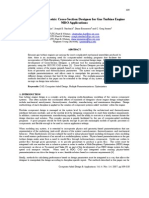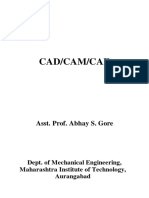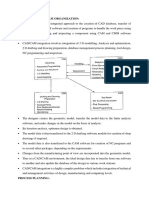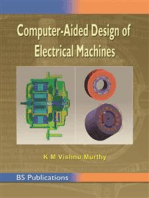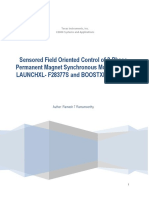Template-Based Integrated Design: A Case Study: Ali K. Kamrani and Abhay Vijayan
Template-Based Integrated Design: A Case Study: Ali K. Kamrani and Abhay Vijayan
Uploaded by
murgadeepCopyright:
Available Formats
Template-Based Integrated Design: A Case Study: Ali K. Kamrani and Abhay Vijayan
Template-Based Integrated Design: A Case Study: Ali K. Kamrani and Abhay Vijayan
Uploaded by
murgadeepOriginal Title
Copyright
Available Formats
Share this document
Did you find this document useful?
Is this content inappropriate?
Copyright:
Available Formats
Template-Based Integrated Design: A Case Study: Ali K. Kamrani and Abhay Vijayan
Template-Based Integrated Design: A Case Study: Ali K. Kamrani and Abhay Vijayan
Uploaded by
murgadeepCopyright:
Available Formats
Chapter 2
Template-Based Integrated Design: A Case Study
Ali K. Kamrani1 and Abhay Vijayan2
Abstract This chapter discusses the application of concurrent engineering principles in the product development phase to achieve maximum cost reduction by foreseeing the manufacturability constraints and solving perceived problems beforehand in the concept-generation phase itself. This would entail integrating the different phases, namely, design calculation, computer-aided design, and process planning. This design methodology is applied to the process of shaft design and bearing selection in the product development phase of a motor. The design calculations include a force analysis and also bearing life calculations. The output from these design calculations is used to develop drawings in integrated design and engineering analysis software (I-DEAS). These designs are then used to carry out a time and cost analysis.
2.1
Introduction
The increased globalization of the manufacturing industry opened up new markets with varying customer requirements and also increased competition with more number of companies by introducing low-cost products. This caused an acceleration in the rate of product change which forced engineers and managers to respond with products having lower cost, better quality, and shorter development times. As a result, companies started reinventing their product development methodologies. One of the areas that have gained importance due to this is concurrent engineering. Concurrent engineering techniques have gained wide acceptance in the high volume manufacturing companies such as automotive and consumer electronics markets. It has also gained importance in the low volume, high innovation industry of aerospace. Concurrent engineering is defined as an integrated and systematic approach to the design of products and their related processes, including manufacture and support.
1 Associate Professor, Department of Industrial Engineering, University of Houston, Houston, Texas 77004 2
Department of Industrial Engineering, University of Houston, Houston, Texas 77004
A.K. Kamrani, E.S. Abouel Nasr (eds.) Collaborative Engineering: Theory and Practice, doi: 10.2007/ 978-0-387-47321-5, Springer Science + Business Media, LLC 2008
19
20
A.K. Kamrani, A. Vijayan
This approach causes designers to consider the whole product life cycle from conception through disposal while selecting a design [22]. One of the main reasons for concurrent engineering to gain broad acceptance was its impact on time. Second, it got the manufacturing and marketing departments involved early in the product development process. This enabled them to influence the design and obtain a cost-effective and high performance product. It also made full use of latest advances in information technology to develop libraries with complex accumulations of detailed design. Because of this, knowledge gained during the development of one product could be passed on to subsequent product developments [20].
2.2
Problem Description
Any manufacturing process starts with the product development phase. In a sequential engineering approach the design process and the actual manufacturing are considered as mutually independent. The design department develops a product depending on the customer requirements and design constraints and provides engineering drawings to manufacturing. Here the design department does not take into consideration the manufacturing capabilities and the process limitations on the shop floor. The manufacturing department then carries out a manufacturability analysis of the design and returns it back to the design section with a list of manufacturing concerns. Here each department passes the design or drawings back and forth until they achieve functional success. In the concurrent engineering approach, this back and forth movement of drawings is completely eliminated since manufacturability concerns are addressed in the design phase itself. Once the design is finalized, resources have to be assigned for manufacturing the product. This is carried out in the process planning phase. In a manual process planning environment, each process plan reflects primarily the experience and skills of the individual process planner; hence it is difficult to maintain consistency and discipline in the planning process [5]. It also acts as a significant break in the automated flow of data from CAD to CAM. Hence it is necessary to automate process planning along with the design phase and allow smooth integration of the two. Advances in information technology and increase in the processing speed of computers help to develop libraries which contain all the data required for manufacturing. This also eliminates the need to develop a new process plan from scratch if a similar product component has already been manufactured.
2.3
Problem Solution
Modifications made to the product in the design phase have maximum impact on the cost and functionality of the product [15]. Hence, we would be concentrating on applying concurrent engineering principles in the product development stage
2 Template-Based Integrated Design: A Case Study
21
and thus achieve maximum cost reduction by foreseeing the manufacturability constraints and solving perceived problems beforehand in the concept-generation phase itself. In an integrated CAD/CAM environment, parts are detailed using a computer graphics system. The system stores the geometric information necessary to create process plans. These process plans determine the machining processes, tools, and machines required to convert a part from its initial form to the desired form. To apply this methodology, we have to interlink the different phases of the manufacturing process. The template-based system can be divided into three different parts: 1. Design calculations. 2. Drafting. 3. Process planning. The system schema is illustrated in Fig. 2.1. The user requirements are analyzed and converted into input parameters for the design calculation phase. The output from the design calculations is utilized as the control parameters for selecting feasible drawings from the CAD system. The process planning module uses the CAD data and then generates route sheets as well as a cost analysis of feasible designs. This enables the designer to study the impact on the design on the basis of cost and manufacturing capability. The template-based design methodology is used for the bearing selection and shaft design process of an electric motor. The input parameters are speed, power of motor, and also the minimum life of bearing required. This information is then used to obtain the parameters for CAD models. The CAD modeler then returns feasible part drawings which act as the input to the process planning phase. The process planning module prepares the route sheet and carries out a time and cost analysis for different feasible part drawings and returns it to the user.
Input parameters Part Drawing Process Plan (Route Sheet) User Interface Computer Aided Process Planning
CAD Control Parameters
Drawing Templates
Process Templates
Fig. 2.1 Basic system schema
22
A.K. Kamrani, A. Vijayan
2.4
Electric Motor
An electric motor converts electrical energy to mechanical energy. Alternating current motors are classified into polyphase synchronous motor, and single-phase or polyphase induction (asynchronous) motors. In polyphase synchronous motors, magnetic field associated with the rotor results from a rotor winding (electric field) excited by direct current via slip rings or from permanent magnets on the rotor structure. In single-phase or polyphase induction motors, the rotor magnetic field is created by electromagnetic induction effects [9]. There are two common features for all types of motors. The first feature is that, for an average torque to be produced, magnetic fields of the stator and the rotor must be stationary with respect to each other. The second feature is, for a specific rotor length, air gap diameter, and speed, there is a maximum average power output rating. In induction motors, power is transferred from the stationary part (stator) to the rotating part (rotor) [10]. The stator is made of a stack of steel laminations with insulated slots opening to the inside diameter and holding stator coils or windings. The rotor is also made up of slotted steel laminations. The rotor conductors and end rings are formed using a die cast process. The rotor stack length is approximately equal to the length of the stator stack and its outside diameter is smaller than the inside diameter of the stator packet by twice the air gap. This rotor packet is fitted on the shaft. The shaft is supported on the bearings. The end of the shaft where the power is transferred through a pulley or coupler is called the drive end. The other end is called the nondrive end. An external fan is mounted on the nondrive end of the shaft for external cooling. The proposed design methodology is applied to bearing selection and shaft design of electric motors. The inputs to design calculations are speed, power of the motor, type of drive, and minimum life of bearing required. This information is used to calculate and select the minimum diameter of shaft drive end and also to select the bearings required. Dimensions of the bearings and shaft extension dimensions are then used as the control parameters for CAD template retrieval. The process planning module then carries out a cost analysis for the modified product and returns the minimum cost machine to the user.
2.5
Design Calculations
Power (P) and speed (N) are inputs to the design calculation process. The torque (T) acting on the shaft is given by T(Nm) = [1000 60 (P(kW)/N(rpm))]/(2p) The tangential force (Ft) is calculated as Ft(N) = [T(Nm)/(D(m)/2)] (2.2) (2.1)
2 Template-Based Integrated Design: A Case Study
23
where D is the nominal diameter of the pulley or the coupler [16]. Based on the types of transmission, the radial force (Fr) and the axial force (Fa) acting on the shaft at the point of mounting is determined [21]. Forces generated at the elements mounted on the shaft produce bending moments and the power transmitted produces shearing stresses. A shaft force analysis is then carried out for the section at which transmission element is mounted. This analysis includes both the maximum shear stress theory and the distortion energy theory [14]. The stresses acting on the surface of a solid shaft are given as follows: sx = 32M/pd 3 + 4F/p d 2 txy = 16T/pd 3 (2.3)
(2.4)
Assuming that the axial force produces the same kind of stress as the bending moment, max = (2/pd3)[(8M + Fd)2 + (8T)2]0.5 s' = (4/pd3)[(8M + Fd)2 + 48T 2]0.5 (2.5)
(2.6)
From the maximum shear stress theory, the allowable shear stress is given by all = Sy/2n From the distortion energy theory, the normal stress is given by s'all = Sy/n (2.8) (2.7)
where d diameter of the shaft; F axial force; M bending moment; n factor of safety; Sy yield strength; T twisting moment; max maximum shear stress; s' normal stress; all allowable shear stress; and s'all allowable normal stress. The factor of safety for maximum shear stress is taken as 1.5 and for maximum normal stress is taken as 2. The material used for the shaft is alloy steel C1045 with density 7830 kg/m3, whose allowable shear stress is equal to 60 kpsi and allowable normal stress is 92.5 kpsi [7]. Equating max with all and s' with s'all, the minimum required diameter of shaft extension is calculated. The shaft is primarily supported at the bearings. Elements mounted on the shaft include the rotor and the transmission device. A free body analysis of this shaft is carried out and the radial and axial forces acting on the bearings determined. A search heuristic is developed to select all the feasible combinations of bearings from the bearing database that will provide the required life. The process retrieves the bearing dimensions for each bearing and its associated cost. The bearings considered are deep groove ball bearings and roller bearings. The length and diameter of the bearing seat would be the same as the inner diameter and width of bearings used. The power and speed required for the application determine the electrical
24
A.K. Kamrani, A. Vijayan
design of stator and rotor. A database of electrical specifications is created which contains the rotor packet dimensions and its corresponding weight for each combination of power and speed.
2.6
CAD Modeler
Integrated design and engineering analysis software (I-DEAS) is used to generate and store shaft design templates. The shaft consists of the drive end and nondrive end shaft extensions, the drive end and nondrive end bearing seats, and the rotor packet seat. The different dimensions of the shaft are obtained from the design calculations. They include the minimum shaft extension and bearing seat dimensions. The rotor seat dimension is obtained from the electrical design database. The drawings are classified on the basis of the shaft ends as shown in Fig. 2.2. It is either cylindrical or conical. Second classification depends on whether the shaft has extensions on both ends or only one shaft extension. Both end shaft extensions are used either to run a tachometer or to run an external blower at the nondriving end. Further classifications are based on the applications: low speed high torque and high speed low torque applications. Once the template is selected, necessary changes are made in the dimensions and also additional features like undercuts and threading are incorporated. All the changes made to the template are recorded. These modifications are passed on to the process planning stage.
Fig. 2.2 Shaft classifications
2 Template-Based Integrated Design: A Case Study
25
2.7
Process Planning
Process planning is the development of a set of work instructions to convert a part from its initial form to the required final form [6, 11, 12, 19]. In the proposed system, the process plan provides detailed description of the manufacturing processes and machine tools required to make the part. This detailed information includes the list of different machines that are used, specific cutting energy for the work material, cost per hour of operation, standard setup and tear down times, and the number of tools utilized for the process. The process plans are saved in the system database. A search heuristic is developed for selecting the process plan. If the process plan does not exist in the database then a new process plan is generated by selecting machines on the basis of the features, dimensions, and tolerance required for the finished product. The process plan information is used to obtain the time required for manufacturing and also for cost estimation.
2.8 Cost and Time Analysis
Each process plan is linked to a cost analysis chart which gives the costs incurred in the manufacturing process. If a new process plan is generated then a detailed analysis for cost estimation is carried out. The time required for manufacturing a part can be classified into productive and nonproductive time [2, 4]. The productive time consists of roughing and finishing operations. Roughing operations are carried out at maximum power and the time taken is given by: tmp = (60rv psW)/(raW b) = ((60rv ps)/(ra)) W(1-b) (2.9)
where rv proportion of initial volume of workpiece to be removed by machining, ps specific cutting energy, density of work material, W initial weight of work material in pounds, and a, b constants for machine tool type. The time taken for the facing operation at maximum power condition (tmpf) is given by tmpf = 60 Vm ps /Pm (2.10)
where Vm volume of material removed and Pm maximum machining power. The time taken for the finishing operation depends on the surface generation rate Rsg for the material. It is the product of speed and feed and is the rate at which machined surface is generated. Rsg for alloy steel work piece and high speed steel tool is found to be equal to 23.7 in.2/min [3]. The finished machining time is given by tmc = (60Am)/Rsg where Am surface area to be generated. (2.11)
26
A.K. Kamrani, A. Vijayan
The tool replacement time is accounted for by modifying the roughing and finishing time equations as t = tmp [1 + (n/(1n)) (tmc/tmp)(1/n)] mp when tmc/tmp < 1, and t = ((60Am)/Rsg) (1/1n)) mc (2.13) (2.12)
where n is the Taylor tool life index and depends on the material of the tool. Value of n is taken as 0.123 for high speed steel tool [4]. The nonproductive time is calculated as tnp = (tsa + nt tsb)/Bs = tln + notpt (2.14)
where tsa basic setup time, tsb setup time per tool, Bs batch size, tln loading and unloading time, tpt tool positioning time, and no number of operations. The loading and unloading time depends on the weight of the workpiece and is given by tln = c d W (2.15)
where c and d are constants and have values 38 and 1.1, respectively, for a lathe [8]. The total rate for the machine and the operator is given by Rt = (km e Wf)/(2 ny ns) = ko Ro (2.16)
where Ro direct labor rate, km factor for machine overhead, ko factor for operator overhead, e, f constants for a given tool, ny amortization period for the cost incurred, and ns number of shifts. The total cost of manufacturing can then be calculated by multiplying the cost rate with the total time required for the process. The manufacturing cost Cman is given by Cman = Ro (tmp + tmc + tnp) when tmc/tmp 1, and Cman = Ro (tmp + tmc + tnp when tmc/tmp < 1. Bearings are normally procured from a vendor. If the bearing required can be found in the bearing database then its corresponding cost is retrieved and used in calculating the total cost. If the bearing cost is not available in the database, then the relative cost of the bearing is determined using polynomials [17]: (2.17)
2 Template-Based Integrated Design: A Case Study
27
P3(X) = a3X3 + a2X2 + a1X1 +a0
(2.19)
where a3, a2, a1, a0, coefficients, X standardized dimension, and P3(X) thirddegree standardized cost function. The coefficients a3, a2, a1, and a0 are obtained from the following set of equations. The total cost for the design including the bearing procurement cost and the manufacturing cost is reported for all the machines that can be utilized to manufacture the shaft. This estimate helps the designer to select the minimum cost alternative along with the machine information on which it can be processed.
2.9
System Components
The structure of the system is divided into four major components: design calculations, bearing selection, design template retrieval, and machine selection with process cost estimation. These components are illustrated in Fig. 2.3. In this system, the product specifications are the input for carrying out design calculations. The external forces acting on the bearings and the shaft extension is calculated. The design calculations also retrieve the electrical design data for rotor packet from the database. A search heuristic is implemented for selecting a minimum cost bearing which can withstand the external forces acting on it. The features required and dimensions of the bearings, rotor packet, and shaft extension are used to retrieve the CAD templates. The template information is used for selecting the machine and carry out a process cost analysis. The output from each component is reported back to the user interface. The system is implemented on a personal computer equipped with a Pentium-4 processor and Windows XP operating system. The graphical user interface, search heuristics, and design calculations are developed in Microsoft Visual Basic (.NET platform). The relational database is developed in Microsoft Access 2003. The 3-D models are generated in I-DEAS and imported into Visual Basic which acts as the drawing templates.
28
A.K. Kamrani, A. Vijayan
Product Specifications
User Interface
Relational Manufacturing Database
Design Calculations
Electrical Database
Bearing Selection
Bearing Database
Design Template Retrieval
CAD Templates
Machine Selection
Machining Database
Cost Estimation
Cost Database
Fig. 2.3 System structure
2.10
Design Calculations
The power and speed entered in the user interface is used to search the electrical database to retrieve specifications of the rotor packet. These specifications are used to calculate the radial and axial magnetic forces acting on the shaft [1]. The radial force acting on the shaft is given by: Fmr = (0.1 + 0.005SID) [(0.25RL.SID)/ (5AG)] (2.21)
You might also like
- NZ200 Manual 16003哪吒机Document38 pagesNZ200 Manual 16003哪吒机Daniel100% (4)
- Cad Cam Third Edition Solution ManualDocument155 pagesCad Cam Third Edition Solution ManualGabriel Dias100% (2)
- Google Cloud Platform for Data Engineering: From Beginner to Data Engineer using Google Cloud PlatformFrom EverandGoogle Cloud Platform for Data Engineering: From Beginner to Data Engineer using Google Cloud PlatformRating: 5 out of 5 stars5/5 (1)
- CATIA Full Book 2 Print - 2Document147 pagesCATIA Full Book 2 Print - 2Sum Sumne Sumanth100% (1)
- The New 3D Layout for Oil & Gas Offshore Projects: How to ensure successFrom EverandThe New 3D Layout for Oil & Gas Offshore Projects: How to ensure successRating: 4.5 out of 5 stars4.5/5 (3)
- AutoCAD Electrical 2017 for Electrical Control Designers, 8th EditionFrom EverandAutoCAD Electrical 2017 for Electrical Control Designers, 8th EditionRating: 3 out of 5 stars3/5 (1)
- Simulation of PMSM Speed Control System-53291344Document6 pagesSimulation of PMSM Speed Control System-53291344Mmahm 1238No ratings yet
- CHAPTER 10 Position and Warning SystemsDocument14 pagesCHAPTER 10 Position and Warning Systemsখালিদহাসান80% (5)
- CAD-Based Parametric Cross-Section Designer For Gas Turbine Engine MDO ApplicationsDocument10 pagesCAD-Based Parametric Cross-Section Designer For Gas Turbine Engine MDO ApplicationsValiyakattel NilsNo ratings yet
- CAD - CAM - CAE Notes PDFDocument101 pagesCAD - CAM - CAE Notes PDFgoreabhay100% (1)
- On Case Studies For Concurrent Engineering Concept in Shipbuilding IndustryDocument16 pagesOn Case Studies For Concurrent Engineering Concept in Shipbuilding IndustryAman BaghelNo ratings yet
- Article MechanismMachineTheory Budinger PDFDocument17 pagesArticle MechanismMachineTheory Budinger PDFfei312chenNo ratings yet
- Review of The CAD Process: Chapter TwoDocument49 pagesReview of The CAD Process: Chapter TwoAlagu MurugesanNo ratings yet
- Computer Aided Process Planning - CIM 1123Document53 pagesComputer Aided Process Planning - CIM 1123Raunak GuptaNo ratings yet
- KBE Approach To Automotive StructureDocument10 pagesKBE Approach To Automotive StructureuratmerihNo ratings yet
- Mechatronic Model-Based Design Applied To An H-Bot RobotDocument18 pagesMechatronic Model-Based Design Applied To An H-Bot RobotMarian VerdeNo ratings yet
- Role of Cad/Cam in Designing, Developing and Manufacturing of New ProductsDocument4 pagesRole of Cad/Cam in Designing, Developing and Manufacturing of New ProductsInternational Journal of Research in Engineering and TechnologyNo ratings yet
- Tugas Mandiri Parametric DesignDocument10 pagesTugas Mandiri Parametric DesignfebriannnnnnnnNo ratings yet
- Sub Eme 501 30sep14Document648 pagesSub Eme 501 30sep14Sigit Eka Duwi TamaNo ratings yet
- Computer Aided Process Planning (CAPP)Document30 pagesComputer Aided Process Planning (CAPP)brijkishor2017100% (1)
- Chapter3 - Concurrent Engineering PDFDocument15 pagesChapter3 - Concurrent Engineering PDFSandeep GogadiNo ratings yet
- XXXX Inj MOld Cost EstimationDocument23 pagesXXXX Inj MOld Cost EstimationAmitava DattaNo ratings yet
- Unit - 1: Question: Explain The Design Process With Computer and Without ComputerDocument17 pagesUnit - 1: Question: Explain The Design Process With Computer and Without Computerbrar352No ratings yet
- Design Through Engineering Integration of Connecting ROD: AbstractDocument4 pagesDesign Through Engineering Integration of Connecting ROD: Abstractketthegr8No ratings yet
- Computer Aided Process Planning Full Seminar ReportDocument32 pagesComputer Aided Process Planning Full Seminar ReportSarath Chandran100% (7)
- DO Seminar ReportDocument18 pagesDO Seminar ReportMithun N Gowda ME-MD-2019-21No ratings yet
- Cadcam Unit-1Document26 pagesCadcam Unit-1kk11091079No ratings yet
- Parametric Design of Dies For Cutting and Drawing Using Catia EnvironmentDocument8 pagesParametric Design of Dies For Cutting and Drawing Using Catia EnvironmentTudorache Ionut- IulianNo ratings yet
- Cad 20S3 2023 72-83Document13 pagesCad 20S3 2023 72-83vipinNo ratings yet
- Chapter 7: Process PlanningDocument6 pagesChapter 7: Process Planningஅன்புடன் அஸ்வின்No ratings yet
- CIM Module 2Document64 pagesCIM Module 2Mohanakumara K CNo ratings yet
- Cybercut: An Internet-Based Cad/Cam SystemDocument33 pagesCybercut: An Internet-Based Cad/Cam SystemJitendra JainNo ratings yet
- SeminarDocument23 pagesSeminarAchu KuttyNo ratings yet
- Product Design and Concurrent Engineerin UNIT 1Document22 pagesProduct Design and Concurrent Engineerin UNIT 1Nabila RasgadoNo ratings yet
- CAD CAM CAE Notes PDFDocument101 pagesCAD CAM CAE Notes PDFSatyaprakash Dinesh VisputeNo ratings yet
- Boom Bucket2Document6 pagesBoom Bucket2Praveen KumarNo ratings yet
- Introduction To Reverse Engineering: October 2007Document10 pagesIntroduction To Reverse Engineering: October 2007Sudeep Kumar Singh100% (1)
- Metal FabricationDocument18 pagesMetal FabricationReddi GnaneswarNaiduNo ratings yet
- LCI Report Config - EnglDocument19 pagesLCI Report Config - EnglMihai Cristian LascuNo ratings yet
- Cad Notes in Word1Document71 pagesCad Notes in Word1arunNo ratings yet
- Cad-Cam Manual PDFDocument34 pagesCad-Cam Manual PDFM.Saravana Kumar..M.E100% (3)
- The Development of Computational Model Through Reverse Engineering - Side Mirror Case StudyDocument18 pagesThe Development of Computational Model Through Reverse Engineering - Side Mirror Case StudywanameiNo ratings yet
- Design of Spoon Mold Using Flow Analysis and Higher End Design SoftwareDocument6 pagesDesign of Spoon Mold Using Flow Analysis and Higher End Design SoftwareashishNo ratings yet
- Satchit EssayDocument5 pagesSatchit EssayAJones394No ratings yet
- Advanced Design Environment For Screw MachinesDocument9 pagesAdvanced Design Environment For Screw MachineshebsonbezerraNo ratings yet
- Investigation On Automation of Lathe Machine: ArticleDocument7 pagesInvestigation On Automation of Lathe Machine: ArticlePrashant RajoleNo ratings yet
- Cad/Cam: Chapter TwoDocument172 pagesCad/Cam: Chapter TwoMoathNo ratings yet
- A Parametric Blade Design System - AndersDocument50 pagesA Parametric Blade Design System - Andersaxeem1100% (1)
- Design For Manufacturing and Assembly of A Connecting Rod 1362031980Document7 pagesDesign For Manufacturing and Assembly of A Connecting Rod 1362031980addayesudasNo ratings yet
- Computer Aided Design and Manufacturing (Final Submission)Document37 pagesComputer Aided Design and Manufacturing (Final Submission)Momoh OsazeleNo ratings yet
- Computer Aided DesignDocument51 pagesComputer Aided DesignshranjuNo ratings yet
- The Role of Computer Aided Design (CAD) in The Manufacturing and Digital Control (CAM)Document16 pagesThe Role of Computer Aided Design (CAD) in The Manufacturing and Digital Control (CAM)Paddy Nji KilyNo ratings yet
- PLM PDM CPCDocument8 pagesPLM PDM CPCVijay RichardNo ratings yet
- Sequential Versus Concurrent Engineering - An AnalogyDocument8 pagesSequential Versus Concurrent Engineering - An AnalogyPratikKhatmodeNo ratings yet
- ME 473 Unit 6ADocument19 pagesME 473 Unit 6AAma Serwaa YeboahNo ratings yet
- Cad Module 2Document3 pagesCad Module 2Jithumon100% (1)
- Geometric Modeling: Exploring Geometric Modeling in Computer VisionFrom EverandGeometric Modeling: Exploring Geometric Modeling in Computer VisionNo ratings yet
- AutoCAD Electrical 2020 for Electrical Control Designers, 11th EditionFrom EverandAutoCAD Electrical 2020 for Electrical Control Designers, 11th EditionNo ratings yet
- Robotics Chapter 2: Robot Components: Phd. Nguyễn Hoàng GiápDocument54 pagesRobotics Chapter 2: Robot Components: Phd. Nguyễn Hoàng GiápNguyễn Xuân TrườngNo ratings yet
- M.Tech IIT Bhubaneswar - Syllabus of Electrical Power SystemsDocument24 pagesM.Tech IIT Bhubaneswar - Syllabus of Electrical Power SystemsPiyush ShrivastavaNo ratings yet
- Review of Different Control Topologies For The Permanent Magnet Brushless DC Motor DrivesDocument5 pagesReview of Different Control Topologies For The Permanent Magnet Brushless DC Motor Drivesmazza234No ratings yet
- Chapter 1 - Introduction To AC MotorDocument13 pagesChapter 1 - Introduction To AC MotorJiachyi YeohNo ratings yet
- PSCAD Course NotesDocument72 pagesPSCAD Course NotesPacha Mami100% (1)
- Spmman Ab PDFDocument120 pagesSpmman Ab PDFIFeLisTigrisNo ratings yet
- Understanding Inertia Ratio in Synchronous Motor ControlDocument11 pagesUnderstanding Inertia Ratio in Synchronous Motor ControlEder Renato de SouzaNo ratings yet
- 1586175550synchronous Machines - PFC, Infinite BB, Synchronization and Parallel OperationDocument8 pages1586175550synchronous Machines - PFC, Infinite BB, Synchronization and Parallel Operationfaisal sbennaNo ratings yet
- Chapter 3Document66 pagesChapter 3ollata kalanoNo ratings yet
- MOTORING AND GENERATING MODE OF 3-Φ INDUCTION MACHINE - A COMPARATIVE EVALUATION FOR ENERGY EFFICIENCY PDFDocument64 pagesMOTORING AND GENERATING MODE OF 3-Φ INDUCTION MACHINE - A COMPARATIVE EVALUATION FOR ENERGY EFFICIENCY PDFIjabi0% (1)
- PGCET Question BankDocument163 pagesPGCET Question Bankyerale2515No ratings yet
- InTech-Control of Electric VehicleDocument32 pagesInTech-Control of Electric VehicleABHILASH NETAKE100% (1)
- Modelling of DG SetsDocument7 pagesModelling of DG SetsAshish MishraNo ratings yet
- Synchronous GeneratorDocument15 pagesSynchronous GeneratorjvilasisNo ratings yet
- Single Phase Induction Motor No Load and Blocked RotorDocument17 pagesSingle Phase Induction Motor No Load and Blocked Rotorkuttappan josephNo ratings yet
- Implement Five-Phase Permanent Magnet Synchronous Motor Vector Control Drive - SimulinkDocument11 pagesImplement Five-Phase Permanent Magnet Synchronous Motor Vector Control Drive - Simulinkrrdpereira100% (1)
- Altivar Process ATV6000 - ATV6000C163A6666NA3Document3 pagesAltivar Process ATV6000 - ATV6000C163A6666NA3Emmanuel QuitosNo ratings yet
- GATE EE 2017 Set 2 Free MockDocument50 pagesGATE EE 2017 Set 2 Free MockChilukuri JithendraNo ratings yet
- AC Machines (Induction Motors)Document2 pagesAC Machines (Induction Motors)marlon desaculaNo ratings yet
- Assignments 1, 2, 3Document7 pagesAssignments 1, 2, 3Mude Kishore NaikNo ratings yet
- Induced Voltage in A Three Phase Generator VDocument43 pagesInduced Voltage in A Three Phase Generator VPao Castillon100% (1)
- Sensored FOC of PMSM - XL - BPDocument48 pagesSensored FOC of PMSM - XL - BPmanikanta241No ratings yet
- EE-260 Lecture 19Document18 pagesEE-260 Lecture 19qasimbilal salarNo ratings yet
- Dronacharya PDFDocument5 pagesDronacharya PDFStishuk HFNo ratings yet
- T60 ODP 60Hz 4160V - Data and CurvesDocument6 pagesT60 ODP 60Hz 4160V - Data and CurvesIfran SierraNo ratings yet
- EE8401-QB - by WWW - EasyEngineering.net 2Document15 pagesEE8401-QB - by WWW - EasyEngineering.net 2Lokey LokeshNo ratings yet
- Reactive Power ControlDocument73 pagesReactive Power Controlمحمد سليمان100% (2)









